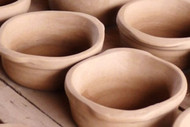Building Wheel Throwing Skills
Posted by Kate Manville-Schwartz on Jul 14th 2021
Creating wheel thrown pottery is about craftsmanship, almost everyone starts out learning the same things, how to position your bodies and hands, how to pull up and move the clay into the shapes that you want. When teaching students their first wheel throwing class, I've noticed many come very intimidated by a rapidly moving tool like the potters wheel.

I've found it is great for moving hand-building ceramics students into being wheel throwers is having them use both techniques to create a new vessel. It's a great way for beginner students to get their feet wet with the wheel while still using what they already know. First, we start out with making a palm sized pinch pot, hand building of course makes vessels more organic feeling. The walls are more bumpy and have indentations from fingers. Then we use small balls of wet clay to center them on the bat, bottom side up. This can be tricky and take a moment to find the right spot, but it gives the student experience in how an uncentered piece of clay will look and feel like. I instruct them to score the bottom where the 'foot' of the pot will be and we add another ball of wet clay, like you would a handle to a mug. Now comes the tricky part, we slip the ball onto the bottom of the pot, drop our center hole carefully and then start pulling up short walls to create a perfectly circular pedestal for the hand built vessel. This lesson can teach students about listening to the capabilities of clay while also simultaneously telling it what to do. Working with clay is often like that and the more experience I can give my students, the more success they can have sitting at the potters wheel in the future.
Our ceramic tools and wheels are available every Wednesday during Open Studio and many of my ceramics students return to take advantage of that every week. You can reserve your studio time here.
Also, I am offering Private Wheel throwing sessions every Tuesday evening for ages 12 and up, no previous experience with clay necessary! Grab your one on one lesson here.
This short video shows our lesson as I have explained it above.

